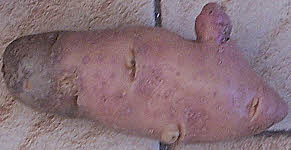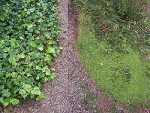
Organic Gardening Diary
Welcome to my organic gardening blog - where I post updates on my garden, the challenges, successes and failures along with what you need in your garden now:- Seasonal gardening jobs & how to tackle problems e.g. pest control, drought, frost...
- Gardening advice when you need it, - but I may take time away,
- Summaries of new web pages plus updates to existing information,
- The growing, gardening & environmental issues that no one wants to discuss.
Jan 02, 2020
Growing Potatoes
Growing potatoes at home beats all you can buy. Enjoy exceptional varieties available to gardeners, enjoy fresh new spuds too. Start here to improve your garden or grow potatoes on the patio.
Sep 03, 2016
Organic Gardening Home for Growing
Grow naturally with organic gardening. Discover how you can enjoy an active healthy life, while reaping the benefits of your own-grown flowers, fruit, vegetables & herbs.
Jul 03, 2015
How To Grow Lots More Tomato Plants
Would you like more tomato plants? Have you grown from select F1 seeds, or did you buy tomato seedlings? 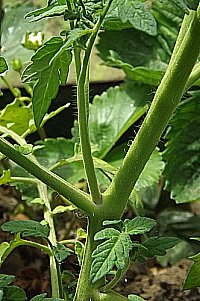 May be you bought just 4 plants but could have easily grown 10. Perhaps your F1 seed packet contained very few seeds.
May be you bought just 4 plants but could have easily grown 10. Perhaps your F1 seed packet contained very few seeds.
Now where cost limits growth - as economists might say - you're going to love this tip for when you just don't have enough and like me want more. Because although your plants are expensive, propagating them is easy.
First Let's Get Familiar With Tomato Plants & How They Grow
There are 2 main types of tomato plants.Determinate or Bush Tomatoes
These branch and grow to a determinate size, rather like a bush. They need more room to spread but don't really need any support. 'Cherry Falls' and 'Shady Lady' are examples of determinate varieties, 'Roma' and 'Marmande' are described as semi-determinate.
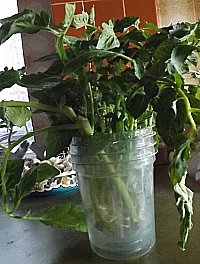 Bush tomatoes tend to produce all their branches early in the growing phase. So although you can take cuttings to grow more of them, this reduces the yield from the original plant.
Bush tomatoes tend to produce all their branches early in the growing phase. So although you can take cuttings to grow more of them, this reduces the yield from the original plant.
Nevertheless, just 1 or 2 cuttings from say 3 plants could give you 6 to 9 plants total. They root and grow quickly.
Note that bush tomatoes are more likely to produce thier whole crop more or less together. You will be extending the vigorous phase of your tomato season.
See below about growing them in pots.
Indeterminate or Vine Tomatoes
These are more common and include varieties such as 'Alicante' 'Gardener's Delight', 'Shirley'.
Vine tomatoes produce leafy axillary shoots that grow from between the leaf stalk and main stem. We usually pinch them out to concentrate resources into flowers and fruit. Vines grow straight up supported by trellis, poles or wires from above.
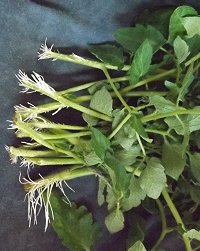 Axillary shoots on vines are ideal for taking cuttings. You will be rewarded with still vigorous vine plants when age and disease are catching up to your earlier grown plants.
Axillary shoots on vines are ideal for taking cuttings. You will be rewarded with still vigorous vine plants when age and disease are catching up to your earlier grown plants.
If pot grown they can be brought inside your patio window or sit on your window sill. Container grown plants could be moved outside during the day.
Taking and Growing Cuttings Is Easy
Axillary shoots can often be snapped off cleanly. Don't take shoots with flowers or else remove the flowers on cuttings.
Use a sharp clean knife. Place cuttings under clean running water, use sharp scissors for a clean cut, then swiftly place in a container of clean water and place in a light position.
Several cuttings take up water very quickly so do ensure the cut ends remain submerged, preferably deep, as roots will branch out of the side.
I prefer clean water to compost because it is cleaner. As soon as roots appear the cuttings should be placed in compost. You will have strong new plants in no time.
Jun 20, 2015
Thornless, Fragrant, Climbing Rose
The View From My Window Is Roses
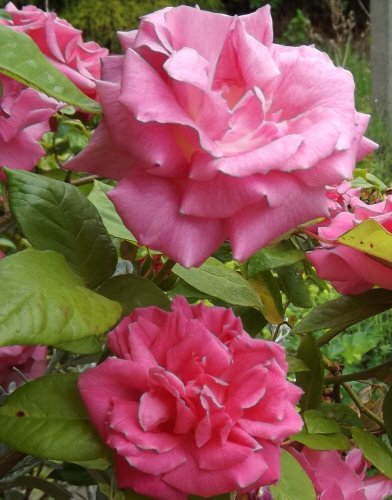
View from my window of climbing Rose Zephirine drouhin.
Rose Perfume
Again, nothing can communicate the exquisite fragrance of my splendid climbing rose. No feeble scent this. Open the window and my nostrils are caressed with the perfect rose perfume.Thornless Rose You Will Caress
The climbing rose that I have today is the same one my father selected over 30 years ago and it still grows strong and has been reliable every year.Zephirine drouhin is not only a climbing rose, it is also Thornless***. Of course that's a big plus for the gardener when it comes to pruning and tying in. For the rose admirer, the children and pets, there's no danger of a scratch when they sniff it.
Your Garden Bower Adorned With Scent And Beauty
So just imagine, if you can, sitting outside in a sunny bower, surrounded by gorgeous pink flowers and that perfect rose perfume.Mine is growing on a west facing wall and this variety in particular is well hardy. If I ever needed more stock for my garden - it would be easiest to buy new - as roses are grafted onto a root stock. But if you'd like to enjoy this climbing rose in your garden, I've found a few suppliers in your country.
Zephirine drouhin available in the USA on this link.
and
Zephirine drouhin in the UK on this link.
A Rose Bower / Arch Will Be Lovely In My Garden
Actually I also have plans to build such a bower, with a seat, positioned inside my garden. Rose arches and garden seats are hereAn Arch and Garden Seat are available here.
Jun 08, 2015
The Wildlife Organic Garden Just Keeps Growing
Most gardeners like to keep everything neat and tidy, grow in rows. Yet the wildlife garden is for me an integral part of organic gardening.
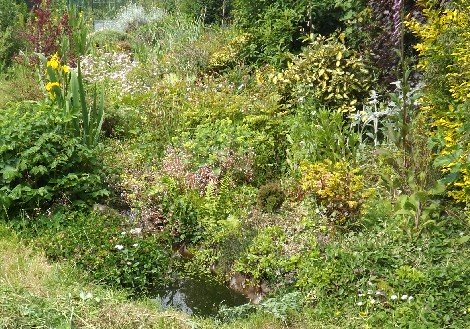
Pond - a channel for life
My garden looks a mess due to loss of detail in photo.
And why not add the pretty flowers of Strawberry plants to the tangled mix and everywhere your summer (indeed your whole year) will be filled with fruity sweetness too.
Today, my writing follows a foray to cut back the wild garden. So here are some important differences that you should know about for managing the wilder side.
Wild Flower Gardening
Firstly, wild flowers and many garden herbs do not need any fertilizer. If you add fertilizer they will grow very lush. Some of the smaller, slower growing plants will then be smothered and lost.Throughout the fall, winter, and early spring, I leave seed heads and dry flower stalks in tact. Most gardeners will be cutting back and tidying. Yet they are removing wild food, hibernation places and nesting material.
I wait until the new shoots are just showing before pruning the old and then because doing this later risks damaging the new shoots. Today I've been catching up on reducing the lush natural growth around my pond.
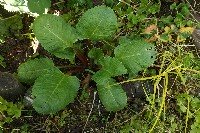
Primula, Houttuynia, Carex
- Pretty perennials were being overgrown but remain quite healthy.
All You Need Do Is Timely Thinning Out
Yet I have also left it until now to cut back because it has been quite beautiful and I wanted to see exactly what will grow back. I have Primula's that, by gardening here earlier, I would have trampled out.Now several types of garden birds will busily move in to feed in the spaces that I've cleared.
Make Room To Grow More And Propagate
Another reason to garden today is that plants growing elsewhere are only now ready for propagation from cuttings. So I can grow these in the available spaces I'm clearing. When my work is done today I will again have more to look forward to.
Very often one job leads to another. In fact my first job today was to complete potato planting, but I discovered a lovely fragrant plant Russian Sage Perovskia atriplicifolia, that needed thinning so as to make more room. It will be much better when growing in several other places in my organic garden.
My organic garden blurs the lines between wild and productive. Every place is friendly.
Continue reading "The Wildlife Organic Garden Just Keeps Growing"
Jun 04, 2015
What Garden Flavour Should I Harvest Tonight?
An organic garden is packed with choice for your breakfast, lunch or dinner. My main choice of recipe usually happens when I am in the garden as I brush past and pick scented herbs.
These include aromatic flavours ranging from Oregano to Bay Leaf, Sage and Thyme, and slightly sweeter aromatic herbs: Basil, Marjoram, Rosemary and even Lavender.
Add to that, citrus flavours within Lemon Thyme and Lemon Balm, plus the acid lemon of French Sorrel to wrap around fish.
Then I have the sweet tasting herbs of Fennel, Dill, and Sweet Cicely. These are great when added to the sharp flavours in fruit.
Also there is Cutting Celery leaf, and Celeriac is producing stems and leaves now too. Parsley will be along later. For finer flavoured celery try Lovage.
I cannot leave the garden without deciding on what onion flavour to use - there is a big selection here. Should I choose Chives or Spring/Bunching Onion, should I use Garlic Chives available all year in green or go for the milder Leeks that are now bulking up to a nice size for harvest.
So there it is. That's just a small part of my delicious flavour garden. Why not sow some seeds today?
Continue reading "What Garden Flavour Should I Harvest Tonight?"
May 17, 2015
Organic Gardening Must Also Be Wildlife Gardening
One of the greatest things about an organic garden is that it is moving with all kinds of life. Not only will you enjoy a lush green garden over an extended period, you will also enjoy watching a healthy range of natural animal behaviour.
You will see small birds eating grubs and the seeds that you have left on wildflowers. You may see hungry hawks with chicks to feed coming into your garden to pick off live prey, and not just the small flyers. In the pond the water will be wriggling with life.
These are some of the vital signs of a healthy organic garden. Ground cover everywhere, vegetables bounded by companion flowers, and fruit and vegetable plants coming up almost anywhere surrounded by flowers. You just never know what you will find next.
Every Garden Space Is Productive
Although I do grow a food garden with vegetables in rows, I add companion plants. Moreover it is the assortment of food plants that grow in every odd place that seem to add up to produce a massive crop.
The only thing is, I will need to be out almost every day over the days ahead to find and pick the harvest. Each outing will be like a safari, and probably cover a different garden area. Each time I will come back with something good to eat.
What flavour!! - see my next blog.
Continue reading "Organic Gardening Must Also Be Wildlife Gardening"
May 01, 2015
Done For April Garden - More Onions
Still catching up with my onions. I had previously sown early crop onion seed in trays and grown them into strong handsome seedlings on the windowsill.
I had to weed to clear a space first. Then with good fine moisture retentive soil, a narrow hole, placed seedling carefully (mine will be at least 1cm deep) then puddle with watering can and firm soil around. I use the trowel like a lever to firm sideways and gently press the surface down. Well now they look great.
I completed planting about a week or so ago - that was only 21 plants to add to 50 sets and other types of onions. So there's more still to tell you on onions and shallots.
May 01, 2015
Lawn Care Advice
Find essential lawn care tips to improve your green areas. Discover the cause of problem lawns and find the answers here. You really will see the difference in the quality of your grass.
Apr 30, 2015
Done For April Garden - Onions
Well great to be back! Very busy, so I'll write short notes on my organic garden starting with a re-cap for April.
I love the onion family and Garlic Chives have been green all winter, along with stored onions and plenty of stored Garlic.
By April Chives and Welsh Onions are coming up again. During the month I complete planting Garlic cloves. 4 bulbs contain 10+ cloves minimum > 40 Garlic plants - 4 for re-planting = 36 bulbs > yields 360 cloves so a minimum 1 to eat per day, and easy to scale up. Actually with my other Garlics too I have far more.
Also Leeks have been growing over winter and are now bulking up in size handsomely to go in a nice stew.
While that is happening I'm sowing carrots between the Leeks. More about that on Saturday. I promise.
The fact I began mowing my lawn again about mid April reminds me to tell you...
For local gardeners:- there's an open day at Field Crest Garden Wirral tomorrow 1st May 1pm to 4pm for Cheshire Wildlife Trust, to celebrate Britain's Best Lawn - TV gardener Martin Fish will be there & me.
Apr 25, 2015
Fruits on my potatoe plants inca bella
I am going to upload a photo can anyone give me advice, what and why? They are the summer inca bella baby potatoes, this is my first year growing potatoes.
Sep 09, 2014
Raised Bed Potatoes
You can expect raised bed potatoes to be clean & unblemished as there's no digging involved. Find more here on how to grow a clean unblemished potato delicacy even over hard surfaces
May 16, 2014
Plant Your Tomatoes Deep
Hello again, and a special welcome to greenhouse and tomato growers. This year I'm growing 4 varieties of tomatoes, all from seed.
Variety Is The Spice Of Tomato Life
They are 'Ailsa Craig', 'Maskota, 'Harbinger' and 'Tigrella'. Stripy 'Tigrella' tomatoes are now being planted outside among flowers. 'Ailsa Craig' and 'Maskota' are mainly for my greenhouse.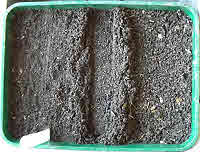
My seed tray contains home made compost
Now the tomato seedlings are robust and ready for planting. Note that seedlings should be handled by the leaves or roots. As stems conduct water and sap, and support the foliage, flowers and fruit, any damage has serious consequences. However in my experience the most likely cause of damage will be due to slugs, or at the extreme by wilting.
Grow Backup Of All Seedlings.
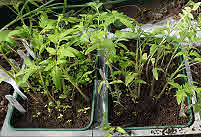
Tomato Seedling Tray
4 varieties from seed.
Spare seedlings for back up.
Already one stem has been grazed but it was easy for me to replace the whole plant.
Tomato Fertilizer?
Modern plant varieties are bred for high yields. They are therefore more demanding of nutrients. This is my excuse to add organic fertilizer as well as garden compost.However, I am conducting experiments yet again to see the affect of leaving out one or more organic fertilizer.
Preparing A Planting Hole.
I dig a spade deep hole and add garden compost (+ or - organic fertilizer). To this I add wilted Comfrey leaves. They release lots of nitrogen and even more potassium - that's ideal for fruit.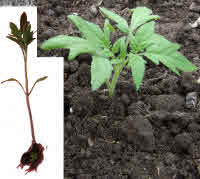
Plant tomato seedlings deep.
Then I replace the soil, breaking down the lumps as I go, and make a narrower but deep hole with my trowel.
Bone Meal adds Nitrogen, Calcium (to help prevent end rot) and Phosphates for good root growth. I may or may not mix it in (results later).
I mix in Seaweed Meal. This is very important for adding micro nutrients, potassium and plant hormones. Elsewhere I experiment by replacing hormone rooting powder with Seaweed meal.
Plant Tomatoes Deep.
Finally I plant my seedling in the deep hole. Deep roots are kept moist and have access to deeper nutrient layers that may be less salty.Also, the buried stem grows adventitious roots providing more root absorbing power.
Well that's it. I'm looking forward to a big crop. All the best to you for organic growing, exercise and healthy eating.
Apr 25, 2014
The Right Time For Growing & Weeding
As I write snow is falling in Vermont again and some of my American gardening friends are only now seeing spring.
So it's not too late to record this simple organic cultural tip from the U.K. Don't clear up your bedraggled perennials too early.
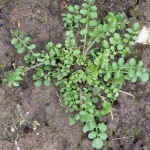
'Hairy Bittercress' Cardamine hirsuta adds flavour to meals.
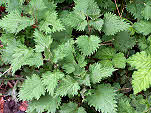
'Nettles' Urtica dioica - cut the shoots to make teas.
The right time to tidy up your plants is just before the new shoots begin to grow. And this is only to prevent accidentally damaging them.
Make Good Use Of Wild Weeds
The photos on the right show two common garden weeds. Cardamine hirsuta 'Hairy Bittercress' is common in my seed beds, overtaking my own sown seeds. However, instead of throwing this easily lifted weed away, select the more succulent plants and chop them into a stew for good flavour.The second picture is Urtica Dioica the 'Common Stinging Nettle'. Leave a patch to grow somewhere and keep it cut down. The fresh shoots can be used to make a healthy tea rich in Silica. It tastes like peas.
And then you will be ready with a home for Peacock Butterfly caterpillars. Elsewhere, keep sowing and planting for a great organic gardening year.
Apr 11, 2014
How To Make Your Earth Right For Seeds
Have you been out sowing seeds? It is the cheapest way to fill your garden with lovely plants and I recommend you do it every week if not every day.
I'd like to show you a good way to prepare your garden soil for seeds - See below...
At this time of year you may have seeds germinating early in boxes indoors. I have lettuce seedlings coming up in my greenhouse already. They will be my first lettuce crop in 2014 and I will transplant some of these outside soon.
Seeds sown outside in the open will be much slower and later. But from the earliest onwards, my supply of vegetables will be continuous.
And so it is important in organic gardening to keep sowing. Because there will be some plant failures. Yet when you always have a wide variety of seeds on the grow every week, then you are sure to get results. And variety is great to have...
 Clod dries from soft/sticky & black |  Clod breaks open cleanly when earth is right for cultivation. |
Summer is coming the earth is getting warmer.
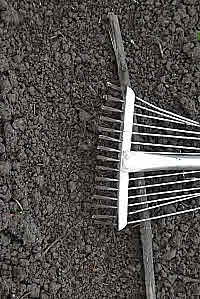
Adjustable Spring Rake
See rakes on garden tool shed & click Rakes link.
Spread the rake so the tines are open a small amount. Then move the tines from side to side along the seed bed that you are cultivating. Hold the tines so they are more or less of a right angle to the direction of travel.
In this way many tines with small gaps between break down the soil into a fine texture. I find this to be a highly effective method.
You can find Adjustable Spring Rakes by clicking the link below and selecting the link to Rakes.
Apr 02, 2014
Create A Frog Patrol To Protect Your Seedlings
What Happened To The Frogs?
About 3 weeks ago there were many frogs on the surface of my pond as large as life and mating - see pictures below on March 8. They are more vulnerable to attack like this, but that's all in the breeding.Then with a small drop in temperature they disappeared.
Satisfied after 2 weeks of romance, they must go somewhere in my garden to feed. The spawn has become a seething mass of wriggling tadpoles still sticking tightly together in a group.
At this time it does not surprise me to find that frogs die in the garden too. An occasional frog can be found lying on its back. The biggest may survive best, I hope the smaller ones don't die from lack of food. So where have all the frogs gone?
Lesser Celandine is Sheltering My Frogs...
I mentioned this wild weed below on my previous blog of March 31.Wherever I leave this early flowering plant it provides nectar and pollen for wildlife. The dense clumps of heart shaped leaves also give moist shade and shelter for all my frogs!
So by leaving this wild weed to grow around the plants I want to protect - such as lettuce or brassica seedlings - I gain an effective Frog patrol to eat plant pests. I'll root it out from the veggies later.
Now that may not be perfect but I have many other innocuous ways to protect your plants in addition...
More gardening soon...
Continue reading "Create A Frog Patrol To Protect Your Seedlings"
Apr 01, 2014
On Top of The Organic Gardening Heap
Let's look at a few ways to reduce slug pests. The top of a heap contains lots of compost worms. Among the rough organic matter you are also likely to find quiet a few slugs.
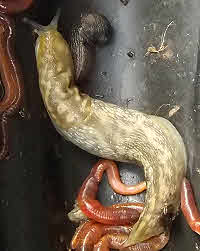
Leopard Slug & Garden Slug. Hiding under the lid on garden compost.
However, the top of your heap could be a breeding ground for slugs as they are well protected from predators here. There is a possibility that their eggs could pass through a cold heap to the bottom.
A problem arises if you have an abundance of slugs breeding in your heap leading to an explosion in numbers. The Leopard slug seen in the photo apparently breeds in a tree - surprise! But where does it lay its eggs?
To kill the slugs that you see in your heap, simply slit them with a pair of scissors. They become part of the compost and are eaten by other slugs.
Digging around back in the garden there seem to be quite a few small slugs in evidence. With the temperature warming and the soil still moist, it is a good time to consider applying an anti-slug bio-control such as Nemaslug. Useful links - and there's more below on Frogs.
Use biological control by specific nematodes for particular pests.
More later on how to get Frogs to patrol the growing areas that you want them to protect...
Mar 31, 2014
There's food in my garden for early risers
Some of you may not recognize my description of last winter as being mild. Yet for many more of you this is becoming a frequent reality.
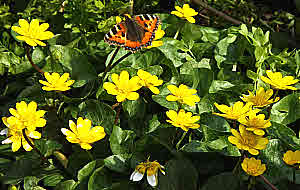
Lesser Celandine with a Tortoise Shell butterfly
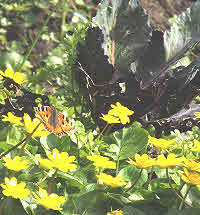
Therefore it is now very important to grow early food plants like the Lesser Celandine pictured here. These wild plants are considered to be weeds, but don't worry about that.
I have many clumps of them. Some as in this picture are even growing around vegetables - here next to Red Cabbage. They will be dug out - roots and all - in a month or two. But not before they provide that vital pollen and nectar for wildlife.
Lesser Celandine spreads rampantly from bulbils and after root tubers are disturbed, so take care to weed it all out. I get away with this by focusing weeding effort selectively on some growing areas. The rest is fine.
Take it easy, as these early clumps of pretty yellow flowers are more attractive than Daffodils. Other suitable plants include Winter Aconite, and Doronicum.
More later...
Continue reading "There's food in my garden for early risers"
Mar 14, 2014
My Special Garden - provides special food all year long
What a delight to see the garden growing again. Here's a
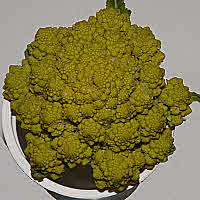
'Romanesco' Cauliflower now - late Feb early Mar - straight from garden to kitchen.
These are small but valuable delights that come from keeping active in an organic garden.
Add to that last year's harvest of Garlic, or growing fresh Garlic Chives, plus fresh beetroot - left in the ground - plus a few carrots that I missed earlier but I'm still pulling now... ...
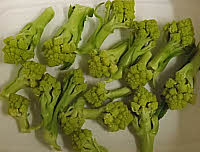
Individual florets ready to be cooked.
Gardening with seeds can bring you many unusual and attractive varieties that you don't get in stores.
Indeed the mix of grow your own veg on the following links is the most colorful and attractive I've ever seen - Rainbow carrots, Rainbow Chard, stripy Beetroot and pear shaped tomatoes, beautiful Radicchio, tasty salad leaves and herbs.
These grow-your-own links help you serve more attractive and healthy meals that you and your children will love. You'll find easy to grow potatoes that are unique in shape color and good flavour.
Why not try the attractive vegetables on the links below in your flower borders too.
Organic Kitchen Garden - can't miss these:
- Garlic - very healthy for you & it's used to protect other plants. I also have early and late onions, shallots, leeks and spring onions. Never be without great flavour.
- Potatoes - nowadays they come in an interesting range of shapes, textures and colours.
- Beets & Swedes - health protecting antioxidants are found in red coloured vegetables. Add to that crunchy red radicchio.
- Herbs such as origanum, chamomile, marigold, nasturtium, mint, help to protect your crops, besides adding great flavour to meals.
- Fine tasting Brassicas - Cauliflower in varied shades, and a nice crop of brussel sprouts, plus red leaved Pak Choi.
You'll find Carrot 'Resistafly' is an improvement on 'Flyaway' for larger roots.
I'm also sowing 'Sugar Snax' which is remarkably sweet, plus 'Nantes 2' 'Chatenay Red Core' & 'Autumn King' are my favourites. More coming up later.
Wishing you the very best of health.
Continue reading "My Special Garden - provides special food all year long"
Mar 08, 2014
Which garden animal likes, blinks, smiles...
...And provides an important natural link with WEB feet no less.
Of course - all organic gardeners should celebrate the frog!
Here's a few pictures from my pond taken last Thursday 6th March.
Frog Likes
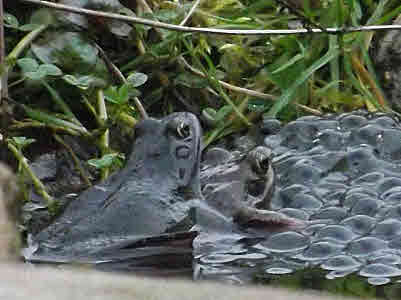
The More Frogs the Merrier.
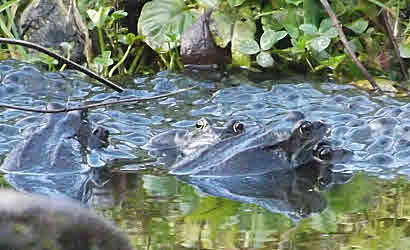
How do I know what they eat? Well slugs definitely decrease in number after you make a thriving pond. I have already started to make a second pond for them.
One frog blinked - so my new camera reported
- so the camera actually detected a FACE here!
I will adjust it to detect a froggy smile.
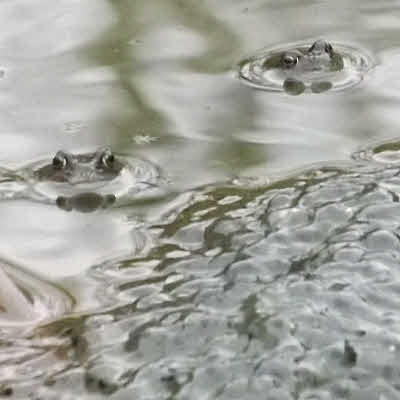
Thinking about capturing your own garden photos? Compact bridge cameras give you the controls to capture quality pics.
Continue reading "Which garden animal likes, blinks, smiles..."
Mar 05, 2014
Your Garden Thrives When Nature Thrives
Is this the last year that you will put up with your crops and flowers being eaten by pests? Is this the year that you will resort to using pest killers?
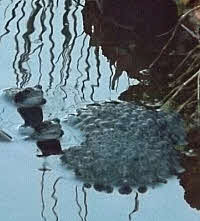
More Frogs please - they are voracious predators.
More than simply not using poisons, organic gardening also involves actually doing something different. It involves nurturing wildlife so as to achieve natural control through balance.
Remember: by killing off the natural controls or by not leaving any room for them to thrive, the pests in your garden get a free run at your plants.
However, by encouraging diversity in your garden, nature controls the pests for free.
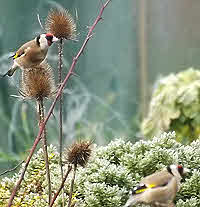
Goldfinch feeding on Teasel in February - but only because I didn't tidy it all away
Now I know life is not perfect. Some damage will occur. However, by ingenuity we gardeners can add in some smart methods that work with nature.
Among these are biological controls, resistant varieties, companion plants, and barriers. I'll be writing more on using all these this year...
But one of the most important controls is nature itself and the eco system you create around your home.
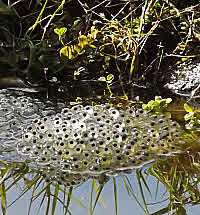
Frog spawn eggs look similar to a lens that concentrates the suns rays to warm the embryo.
Birds are splashing all over the pond but they don't seem to have a taste for eating the nutritious spawn. Nature knows how to survive.
Later I'll be posting my methods on how to combat pests around your plants: slugs, carrot root fly, beetles and more... Be wary of using anything that is an indiscriminate killer even if it is organic in make up.
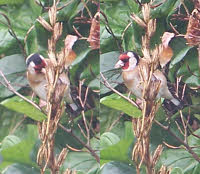
Goldfinch are beautifully colorful with a lovely summer song.
Continue reading "Your Garden Thrives When Nature Thrives"
Feb 22, 2014
Organic Greenhouse Growing Needs Extra Care
When you think about organic gardening all your attention may be on not using poisons. Actually there are many more positive must do activities, such as compost making and companion planting...
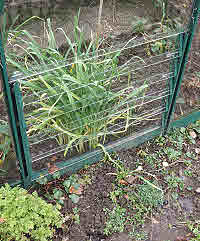
Garlic Chives fresh & clean for eating
Scent may deter pests.
I mean the confined dryish spaces found inside greenhouses, cloches and polytunnels. Why?
Well, we are often told that poison residues biodegrade. Yet under cover the dryish conditions will retard biodegradation. Under protection these synthesised toxic residues have less chance of being washed or blown away.
So the concentration of poisons could increase in confined spaces.
Organic Pest
Controls
on links just below
VVVV
And it's not only poisons you need to take care of. Without rain to wash salts into the soil, salty fertilizers will be drawn up to form a deposit on the surface. This could poison the soil for seedlings.
At this time of year many gardeners will want to give the earth under cover a good deluge of water to wash the problem down.
Of course, if you rely more on nutrients bound into complex organic materials rather than using fast liquid feeds, then this problem is reduced. Actually nutrient removal should occur mainly through the baskets of fruit and veg that you harvest.
Now if you are wondering how to deal with pests in your greenhouse without using poisons, then I recommend you try out biological controls.
Various kinds of specific organism: wasps to eat aphids, nematodes to infect slugs for example, work well in confined spaces. This year I will be trying a special mix of nematodes to control greenhouse ants.
They do need a minimum temperature to get going - nematodes also need moisture. Before then you might simply use vigilance. But whatever you do don't mix poisons with biological controls. Then you really do have the worst of both worlds.
Use biological control by specific nematodes for particular pests.
Continue reading "Organic Greenhouse Growing Needs Extra Care"
Feb 20, 2014
One Week On - Rhubarb is on the March
I'll be taking regular 'my garden' photos this year so you'll actually be able to see my plants growing.
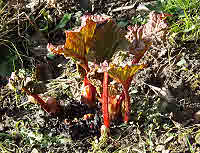
Rhubarb 1 week later than pics below.
I will also be adding a long awaited section on organic vegetable growing. This is so big it has to wait for me to finish my garden.
It's all being worthwhile and very green and healthy... so come again.
Continue reading "One Week On - Rhubarb is on the March"
Feb 15, 2014
Cleaning & Cloches
A big advantage of toughglass greenhouse panes is that one piece
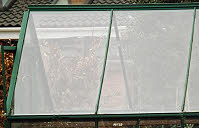
No Overlaps With Toughglass.
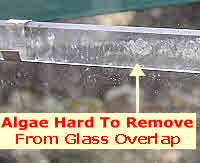
This not only makes construction much easier, it also eliminates those glass overlaps. This is important because when you clean your greenhouse with a cloth or brush you can't reach into that gap to remove any algae.
Even with large panes there are a few overlaps to accommodate shaped glass at gable ends. You can see from the picture that soap has cleaned it, but the algae will grow back from the overlap.
My notes below contain links to some cleaning materials.
Always consider the advantages of cloches in your garden. I recently read an article extolling the virtues of polytunnels, but I can't agree. The experience being described was based on commercial horticulture. Most organic gardens and small homesteads are very different.
Yes a polytunnel can grow all kinds of crops, and get an early start. But cloches will do that for you more flexibly and with less cost. And just to detail my earlier comments on this the heat captured will raise the temperature in a cloche more than in a polytunnel.
Here's the equation:
Heat input is proportional to ground area. Heat required to raise the temperature is proportional to the volume.
Let's illustrate this with a standard cube
A - 6 Feet X 8 Feet X 6 Feet
and one half size in every dimension
B - 3 Feet X 4 Feet X 3 Feet .
Volume of A = 288 cuFt and Ground area of A = 48 sqFt
Volume of B = 36 cuFt and Ground area of B = 12 sqFt
Ground Area / Volume is proportional to the ability of the structure to raise the temperature from absorbed heat.
A - (Ground Area / Volume) = (48/288) = 0.17
B - (Ground Area / Volume) = (12/36) = 0.33
B (0.33) is greater than A (0.17).
The smaller cloche sized structure can raise the inside temperature more than the larger structure.
Clearly you can further reduce the volume and the heat lost through the surface by selecting a tunnel shaped roof rather than a vertical sided square shape. However rectangular forms maximise internal space while curved shapes throw some space outside.
Consider this when comparing several bell jar cloches with one long cloche. Space outside a bell cloche may be wasted.
Continue reading "Cleaning & Cloches"
Feb 12, 2014
My Valentine Always Appears On Time
My garden loves me for real as the delightful Rhubarb 'Valentine' shows up on time once again.
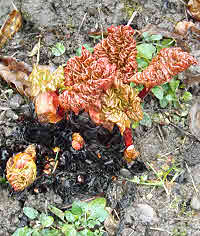
Love from my
Rhubarb 'Valentine' 2014
I should fork some chicken manure into the surface and mulch around it with a thick layer of garden compost.
Some gardeners like to force Rhubarb. They do this by covering the plant completely from light with an upturned container. This produces thin sweeter stems. However, 'forcing' uses up a lot of the plants stored resources. It should only be done in alternate years when you have 2 plants.
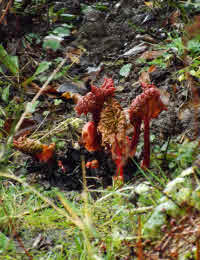
Rhubarb 'Valentine' looking forward to my sweet.
Well I still have 2 more varieties of Rhubarb to come up in my garden. 'Champaign' is showing some signs of growth too.
In the U.K. the Royal Horticultural Society has a national collection of 112 Rhubarb cultivars.
So I think my next buy will be 'Stockbridge Arrow' for attractive accented leaves. With more plants to draw on I can force one. Plus I'll have plenty of healthy filling for pies and crumbles to last a whole year. Check them out on the link.
For my American friends I have a link to Rhubarb 'Victoria'. This one variety has been recognised as a top British variety for so many years it's a tradition.
Now as soon as the ground is workable you can plant perennials like Rhubarb. For Rhubarb prepare the ground with well rotted garden compost or manure, and a good 3 handfuls of an organic fertilizer such as bone meal or hoof and horn. The crowns should be at ground level in earth that doesn't become waterlogged.
Happy organic gardening in 2014.

Continue reading "My Valentine Always Appears On Time"
Feb 08, 2014
Greenhouse Glass Sparkling Clean
Well hello again. I'm writing to finish off the greenhouse cleaning blog. No secrets here - I simply used dish soap and vinegar along with a sponge and scraper, and a long handled brush for the roof. This easy job has made the glass look clean and sparkling again.
I could have used bicarbonate and some people use washing soda, but both these introduce salt. Whatever I use, I would have to buy it. So for your information I've included links to products specially made for the job from plant extracts.
And there's more on maintaining UK greenhouses when you click below...
Do use the Contact the Gardener link on the navigation bar if you have any solutions that you would like to share with my readers or comments about the quality of organic products.
I'm looking forward to lots more organic growing in my greenhouse this year. Cultivating seedlings has already started. You may find more help on the links above and below.
Do consider cloches as a good alternative to a full sized walk in polytunnel or greenhouse. I've outlined some of the physical advantages for gardening below.
Continue reading "Greenhouse Glass Sparkling Clean"
Feb 04, 2014
Organic Mulch
Learn about organic mulch here - homemade mulch, agricultural & forestry mulch. See my recommendations on how to use & not to use organic mulch in your garden.
Feb 04, 2014
Landscape Mulch
Create a neat, easily maintained garden area of natural texture & continuity using landscape mulch
Jan 30, 2014
Get growing under cover now
Welcome to the new gardening year once again. I want to start positive by considering glass or poly houses.
Polythene seems to lack the purity of glass, but the big advantage is that it can be tailored to fit small spaces with ease. And this is a better match for price.
So I've put a link at the bottom to an attractive poly house that includes a versatile ventilated design. I'd really like to see these features built into larger structures where ventilation is even more important.
My own greenhouse is made of coated aluminium and toughened glass, and it's still as good as new. For larger structures a higher price makes durability an important issue.
But with a small poly house it would be possible to move the structure around year on year. Check out the links to see what's new.
Ordinary horticultural glass is the cheapest but potentially dangerous. It breaks into sharp pointed shards. Alternatively toughened glass is tough, and when it breaks it forms glass crumbs that are easy to sweep up.
Polycarbonate has better insulation, it is strong and light but has the problem of being difficult to secure against the wind. It rattles.
Plastic often appears pale rather than clear because it diffuses the light. However, I'm not convinced that UV protective coats will keep this material from dulling and becoming brittle over the life time that I expect to use it. Yet, for a small structure poly makes more sense.
In the next week or so I'll be making up a wash to clean the glass and frames on my greenhouse. In the next blog I'll describe what I've used to get it clean. All the best.
 |  |
| American plant houses for your garden | Plant houses for more British flowers |
 |
Continue reading "Get growing under cover now"
Jan 23, 2014
Polytunnels, greenhouses, or cloches?
Polytunnels have become a fashion but don't get carried away by that if you're a gardener.
Larger producers are attracted by easy to handle and build materials. But for the small gardener the advantages are doubtful. See below...
First, polytunnels are not very adaptable to mounting ventilation, or staging. And for growing many plants adequate ventilation is very important. Your conclusions may depend on the scale of garden that you manage.
Because small is beautiful when it comes to heating - I'll explain why below...Consider cloches if you are not growing tall plants and don't need to walk inside. The heat from the sun is absorbed by all the surfaces inside your poly, greenhouse or cloche. This heat is transmitted to the air inside, and this circulates by convection inside without blowing away.
So think about the ground area relative to the volume inside i.e. the air space.
The greater the ground area the more heat is absorbed. One tip is to hang black strips inside where they don't shade your plants. In winter black polythene over the ground will help absorb more heat from light.
So the larger the volume the more heat you will need to keep the temperature up. The larger the ground area the more heat will be absorbed from light and transferred to the air inside.
So if you are not growing tall plants, and if you don't need to walk inside your plant house, why not consider cloches instead. This tip may allow you to extend your growing season at both ends. But I can't describe using fuel oil to heat plants outside as being an organic method. More on this later...
Do contact me if you have actually tried this and have some results to support my hypothesis.
Continue reading "Polytunnels, greenhouses, or cloches?"
Dec 11, 2013
Growing Runner Beans
Check out my tips on growing runner beans for a nutritious crop that fits into any garden. You can get a bountiful crop for freezing
Sep 17, 2013
Face of The Organic Gardener
Here's just a quick invite with a link to Home of The Organic Gardener on Facebook. I'm adding my pictures, you can too.
Join me there to add your comments and pictures and share it with your friends. We will build a growing community of gardeners. Click below.
Aug 02, 2013
Ventilate Your Greenhouse Garden
Well here's a quick look at my packed greenhouse.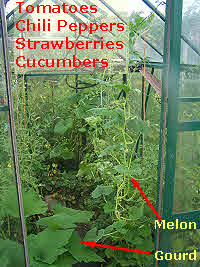 I decided to fill it with everything I could get in - details below...
I decided to fill it with everything I could get in - details below...
First a quick word on greenhouse ventilation.
Today, after very clean growing, I discovered some strawberry fruit overcome with furry botrytis fungi. There are 2 reasons for this outbreak.I've not been ventilating. Concentrating on not letting temperatures go too high I forgot about the need for ventilation. Today I opened the second window, widened both side ventilators and left the door open an inch.
Second reason is that I've been unusually extravagant in watering this year with my underground seep hose. The soil surface usually remains dry but I've had too much water going in overall and the pathway is damp.
Bye-the-way I added liquid feed inside my greenhouse and outside on my potatoes see next post. Don't over do high potash liquid feeds as you'll get blossom end rot and hard growth.
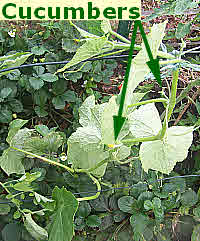 And here's a picture of my cucumber 'femspot'. I'll post another picture when the fruit are ripe for picking.
And here's a picture of my cucumber 'femspot'. I'll post another picture when the fruit are ripe for picking.
2 melon plants are growing up and now as they reach the top the leader will be stopped. Several side shoots will be trained along horizontal wires allowing just 1 melon fruit to grow on each side lateral stem.
What's in my greenhouse?
There are 2 varieties of strawberries - still fruiting - 6 varieties of Chilli Peppers, 4 varieties of tomatoes, 2 x Cucumber 'femspot' 2 Melon 'Sweetheart' several unknown cucurbitaceae which may turn out to be gourds or melons - I mixed up the seeds.All the best to my fellow gardeners for a good greenhouse crop.
Continue reading "Ventilate Your Greenhouse Garden"
Aug 02, 2013
Organic Tomato Fertilizer
Healthy plants from an organic tomato fertilizer that also works for several kinds of greenhouse and herbaceous fruit. To enjoy all the health benefits of your tomatoes visit here.
Aug 01, 2013
Pretty White Butterflies Laying Eggs
Butterflies are great to see but some are laying eggs on my plants...
more below on protection...
I'm enjoying the rewards of diverse planting as my garden is home to a wider range of beautiful fluttering species.
This Silver Studded Blue butterfly might otherwise be seen on Broom / Gorse and heaths but is happy in my garden today.
Chillier air may cause butterflies to fully open wings to bask in the sun. Normally folded wings are less visible to predators. Under cover of darkness moths can spread their wings.
The other frolicking white butterflies may be engaged in territorial claims. They can't be allowed to get away with my garden greens.
Cabbage White butterflies have started laying eggs on my broccoli and cauliflower. The butterflies are distracted to some extent by companion plants such as beans. When insects find the wrong plant they may move to another patch - but not for long.
A natural way to protect your plants is to check them daily and rub out the eggs that you find. This depends on how many plants you have to take care of.
Probably the best protection comes in the form of netting. It is clean and relatively harmless.
Take care and cover your crops
Liquid feed for Tomatoes and Potatoes.
Organic Liquid Feed for U.K. gardensThe July break is long over. With a productive organic garden you will be pushed to keep up with the harvest now. The hedges need trimming too. Indeed they should have been done in July.
p.s. If hedgehogs move around your organic garden take care to bank up the sides of your netting, or add a barge board or strip to prevent entanglement.
All the best.
Jul 25, 2013
Organic Gooseberries & Fruit in Plenty
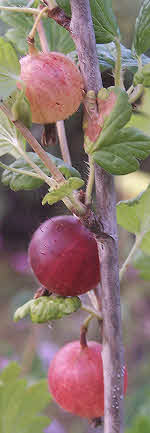
The picture right shows how Gooseberry 'Pax' ripens from pale to deep red. 'Pax' is a thornless Gooseberry.
I suggest that you don't pick the whole crop at once. Pick the largest ripest berries first and leave the others to ripen.
This year the sun has been so hot that the berries are almost cooking on the bush. You may need to pick any berries where that happens.
It's been very dry so if we get a massive down pour of rain the fruit may split. To avoid that I've been keeping the roots moist with my own water.
fruit that you can grow in U.K..
Grow berries in America with this wide selection always attractively priced.
Thornless Gooseberry Bush 'Pax' will ripen to a deeper red yet.
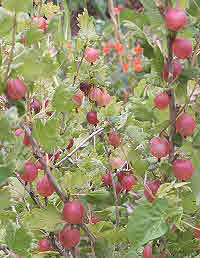
Gooseberry 'Invicta' is a good reliable massive cropper & early.
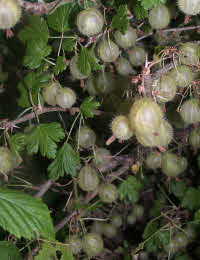
You'll find more organic gardening and meet my friends on this link. You may find it easier to join in here and you are welcome to comment.
Jul 15, 2013
Priority Organic Garden Watering Tips
Get it right when you water your garden
Here are my hot tips.
Always use either a soaker hose or watering can. Except for lawns don't use a sprinkler.
Potatoes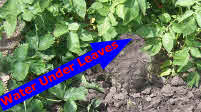
Direct water onto shady ground under the leaves.
Aim to keep the air and the leaves themselves dry to reduce infection with Blight Fungus.
Flowers
Flowers fade earlier when it's dry. Many are on the way to setting seed. Keep flower beds moist.
Use a soaker hose, direct water at the base of the plant.
With plants that are susceptible to slug attack water them in the morning.
Fruit - Gooseberries, Blackcurrants, Raspberries
Soak the fruit bushes as above. Your fruit may have a late 'June drop'. Keep them from drying out and you're fruit will swell up big time and sweet.
Mine aren't quite ready for picking.
Seedlings
Cover sown seed or seedlings with green shade netting.
Run water down a channel next to your seedling row.
Sprinkle dry soil over the surface after you've watered them.
It's not too late to sow. I'll be sowing more French Beans, Carrots, Summer Savory, plus Basil, Kale, and who knows what else. I still have peas coming up. But I'll have to keep them moist and weeded.
It's worth checking this UK Page For Garden Watering cans too.
For American Gardeners check this Perforated Seep Hose and related equipment.
Australian Gardeners see Save Water blog below to get ready for next year.
Jul 13, 2013
Busy but Resting on My Fragrant Chamomile Lawn
It could have been several weeks since your last grass cut. Because grass growth has paused leaving you and I free to take a rest.
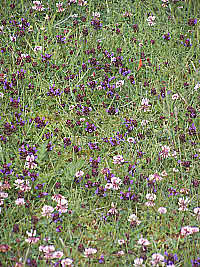 How admirable to have a flowering lawn at this time of year. You have a colourful carpet of low spreading plants: the blues of Self-Heal (Prunella), white and yellow Daisies (Bellis perennis), spreading aromatic Thyme (Thymus serpillum), tiny yellow flowers of Black Medic (Medicago lupulina), and in the same family Clover (Trifolium repens), plus Veronica and Eyebright too.
How admirable to have a flowering lawn at this time of year. You have a colourful carpet of low spreading plants: the blues of Self-Heal (Prunella), white and yellow Daisies (Bellis perennis), spreading aromatic Thyme (Thymus serpillum), tiny yellow flowers of Black Medic (Medicago lupulina), and in the same family Clover (Trifolium repens), plus Veronica and Eyebright too.
To think that commercial horticulture has taught us to eradicate these pretty flowers from our lawns brings tears to my eyes.
What the intelligent organic gardener must know is that commercial lawn care products are designed for specialised greens. Bowling, putting and croquet greens, tennis and cricket pitches, of course need to be uniform and level and flowers can't be tolerated there.

This garden could be a landing site for Dr. Who and his Tardis. Has that bowl of shrubs landed from outer space? How incongruous they look. Perhaps Androids live here.
None of those standards apply to most lawns at home and certainly not at the home of the organic gardener. Here we have a colourful and lively lawn as the pretty flowers attract dozens of insects pollinators.
Compare that with the sterile gravel garden in the next photo. Really it could be a landing site for Dr. Who and his Tardis. No animals live here. Yet this contrast shows how sterile, barren and machine like we have become. :-)
 Get spreading fragrant ground cover here
Get spreading fragrant ground cover here British Plants are at Wholesale prices here
British Plants are at Wholesale prices here
Continue reading "Busy but Resting on My Fragrant Chamomile Lawn"
Jun 28, 2013
Summer Is Breaking Up Wet Again
Here in the north west of England we've had a few good weeks of sun and little rain. Now the weather has broken into grey skies, cool air and even a stiff breeze earlier in the week. So what should you do now?
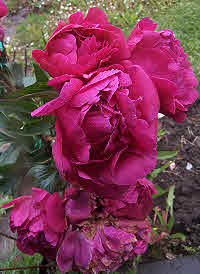 Well first, the heavy Peony flower heads that I'd staked up during the wind now need firming up. The stakes are leaning in the soft ground. So I've added two small rocks to firm the soil around them.
Well first, the heavy Peony flower heads that I'd staked up during the wind now need firming up. The stakes are leaning in the soft ground. So I've added two small rocks to firm the soil around them.
Slugs are out in the day in this wet weather and the birds are enjoying a good feed. Nevertheless it's a good time to apply Nemaslug, a nematode preparation for biological control. Nemaslug sometimes fails if the ground is dry - do follow instructions. But in this weather it works well - we can't have it all ways. You can get it here.
 The best selection for Organic Pest Control that I've seen in the UK.
The best selection for Organic Pest Control that I've seen in the UK. American Gardeners. Scroll down Slug Magic on this page which is another type organic control. I think it works in the wet?
American Gardeners. Scroll down Slug Magic on this page which is another type organic control. I think it works in the wet?
For controlling weed seedlings there's a preparation based on Corn Gluten. Like the weeds it needs damp soil to start off. When the conditions become dry these weedlings dry up as the natural powder does its work. It's great for use around carrots and onions as they don't like weed competition and you need to get them young.
Be sure you get the right stuff - I can only find this in the USA just now.
Of course the damp conditions make it easy to pull weeds straight out of the ground whole. Keep on growing :-)
Jun 27, 2013
Big Organic Vegetables
I want to share this photo I took just 15 minutes ago. 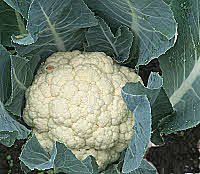
Here's cauliflower 'Igloo'. You may think it gets its name from a resemblance to an Eskimo igloo. Equally the name might come from it's preference for sowing in cold conditions.
I have several of these now that are ready for picking today. I sowed it from seed in my greenhouse during winter. The plants became established and as the days warmed became so large I thought I'd loose them. By the way you can't beat chicken manure as an organic nitrogen fertilizer.
Well I tackled the transplant by removing a large root ball, i.e. keeping roots undisturbed by included a lot of soil. As the greenhouse earth was relatively dry it all held together rather well.
The large holes that I dug outside were well fertilized, garden compost was added, plus bone meal, and I poured in plenty of water.
After replacing the earth I firmed it down well. Also, as the sun was full on, I shaded the leaves for a few days with opaque sheeting.
Great news, these often hard to transplant crops are nearing perfection.
Now to protect your crops from pest attack see the links in the blog below. I have my slug traps on guard around these prize plants.
Jun 26, 2013
Water and Pest Control
Are your plants suffering from slimy critters that come out at night when it's damp.
First - water your plants in the morning. After a sunny day the surface will be dry and less inviting to slugs and snails.
Some plants survive the battle with pests by having their own chemical deterrents. You only have to touch the leaves to smell the odour from your plants.
So grow garlic and give the leaves a bash in the evening to generate the odour.
Equally some pests are surviving by having an attraction for plant scent.
So be very careful with tasty succulent leaves. Don't knock or bruise them as this may attract the pests.
If you're looking for well established solutions to pest control then try the links below.
 The best selection for Organic Pest Control that I've seen in the UK.
The best selection for Organic Pest Control that I've seen in the UK.
 American Gardeners. Scroll down the page on this link to find Slug Magic which is an organic control.
American Gardeners. Scroll down the page on this link to find Slug Magic which is an organic control.
You'll find lots more on the above links for combating all kinds of pest and disease problems.
Comments will be coming to these pages soon - and I'll be explaining how to solve more gardening problems with a creative organic approach based on knowledge.
Happy gardening :-)
Jun 22, 2013
Liking The Organic Gardener
Here's some news for those who like gardening and want to share on favourite social media. Now I'm promoting The Home of The Organic Gardener on Facebook - you can find it on this link http://www.the-organic-gardener.com/OG-FB
Do Subscribe To or Like it so that you can post your comments and pictures. I expect the content to reveal your likes in gardening - your special plants, gardening styles, frustrations etc... Tell us what you think.http://www.the-organic-gardener.com/OG-FB
The blog on this page will continue to update - more frequently from now on - with news of practical gardening challenges that are in season. Here I'll be posting my organic methods to tackle problems and we'll link between each other.
I'll also be starting a network for professional landscape gardeners and growers over at Google plus - more on that later. There'll be news coming up on plans to develop local growing and markets for organic produce.
My long delayed News from The Organic Gardener will be going out by email soon - I'll explain more about how we can keep in touch and learn more from each other. The sign up form is at the top of this page.
Well do check out the link below. This is for all those who want to change the world for the better by growing better. Let’s start now.
Jun 14, 2013
Module Plants Make The Break in Organic Gardening
The long days are lovely but we are having some rain just now. Although it is very welcome - my water butt was completely empty - this weather will give the slugs a chance.
And this is where I find larger module grown plants have already made the break. My cabbages were planted into rich soil as ready grown and robust plants. Now they're growing handsomely.
 Indeed they have outpaced any attacks from the slimy critters. They have become unstoppable.
Indeed they have outpaced any attacks from the slimy critters. They have become unstoppable.
Pea seeds are a problem. They can take quite a while to germinate. The reason they don't seem to germinate outside in my garden is nearly always due to slug attack.
Put your beer traps out. There is nothing more effective at killing slugs. I put the remaining half of a one day opened can of Carling Beer into my trap. Soon it was full of slugs and some very large. Once they go in they don't come out.
All the best to my gardening friends.
Continue reading "Module Plants Make The Break in Organic Gardening"
Jun 05, 2013
Potato Plant From The Ground Up
Here's how a potato plant grows, its origin, growing needs & the diseases affecting potatoes.
May 30, 2013
Gravel Gravel Everywhere & Not a Stone Will Grow
Please, please don't put gravel down in your garden over good ground. You may think it's a great idea to solve your problem. All too often it turns into a very costly mistake.
I continually find myself with gardeners who have messed up with garden gravel. Sometimes it is the previous garden owner who messed up.
Either way too many gardens now need help in digging up gravel and taking it away. This sometimes involves massive quantities. Somewhere else in the country a real mountain has been demolished. Now where will it go?
In other gardens where the gravel is not required to be removed it still creates a massive obstacle to simple planting and good gardening.
Oh it was all a fashion - can I hope for no more? The gravel gardens that were not laid properly with sheeting beneath the stones are growing weeds as I write this. Indeed those weeds are really the best bit of the garden.
So please do the other thing, get out into your garden, plant some spreading ground cover plants and stop messing with nature. It will cost you a fortune.
Alternatively contact an organic gardener for help and do get some better advice.
Continue reading "Gravel Gravel Everywhere & Not a Stone Will Grow"
May 25, 2013
Flower Garden Design
Use these essential flower garden design guidelines when you plan & develop a beautiful garden landscape. This page is a must-read guide for the creative gardener.
May 25, 2013
Lawn Mowers
Find lawn mowers for your kind of lawn. Practical advice on selecting machines for sloping lawns, fine lawns, rough grass, large and small areas... Check their advantages & ease of use here.
May 10, 2013
A Dark and Desert Land
You may have heard the poem about England's Green and Pleasant Land by William Blake. Sadly this vision of living beauty is no more than a memory of our elders.
Nowadays our people grow up knowing nothing of that beauty. Of course they can still look out and see fields. But the singing, vibrant, living nature of our countryside has all but gone.
Even in my lifetime I have witnessed this decline. Gone are the small song birds I once heard like: Yellow Hammer, Sky Larks, Linnets, Redpoll, Buntings and Cuckoo, while Greenfinch, Goldfinch even Chaffinch are following in the same decline.
A silent spring seems to be a real prospect for our land in the coming years.
Here's a few links that may be of interest on this subject. For more on what YOU can do about it read my section below...
Britain's best-loved species in terminal decline
Green and Pleasant Land: hard times for Britain's trees
The above reports were preceded this week by a grim account of the prospects for amphibians like frogs and toads. I heard from conservationists who are currently spending their evenings at roadsides to rescue hundreds of toads from being squashed. A death toll of this magnitude is not something these creatures can tolerate.
As a result, and like our hedgehogs, these creatures are in decline. Does it matter? Yes, it is vandalism to destroy an amphibian species that could hold a medical key to curing human disabilities. And in the same week we have also heard again about the decline of honey bees.
My week was completely spoiled after visiting a farm in the heart of the Cheshire countryside. I couldn't believe my eyes, but the landscape that I saw was merely a blade of grass from being a desert landscape. There were virtually no hedges from horizon to horizon. This exposed place of fields for rearing animals will surely be silent too. I did see some crows.
So what can you and I do about it?
Look at your organic garden. Are you one of the growing number of home owners who have turned to low maintenance gardening by removing plants but topping it with gravel? Are you merely growing a few highly bred attractive but expensive horticultural specimen plants instead of masses of native flowers?
There's really no need to worry about the effect of neonicotinoids if you are not helping the bees and butterflies and other important pollinators by providing their natural food and a place to live. A pond for example will bring frogs, newts and toads to your patch and they will feed on pests such as slugs. Please take a look at this page on natural flowers and the link below will help you plan a better garden.
My Neighbour's Garden
- See my review Garden Shredders posted here. & make easy work of garden maintenance.
- Review the Organic Gardening Blog from the top on this link.
- Use this link to turn your own blogging into real success.
For the most useful
page links please select...
Home of The Organic Gardener ^from the top of this page Thank you for visiting. - There are many more pages about gardening on this website - so take a good browse around, and do let me know your gardening stories too.
Copyright © The Organic Gardener.Com 2004 - 2025.

Also on Home of
the-Organic-Gardener.com
More Links To Pages of Practical Gardening
Information just below.
V V V V V V V V V V V V V V
*One time only*
To find the best page
links for your
garden's region
-
HOME
PAGE - << Wait For Page Load << Wait For Page Load
- Organic Garden Blog
- Grow With Compost
- Garden Tool Shed
- Grow Better Lawns
- Garden Power Tools
- Grow Potatoes
- Organic Fertilizer
- Grow More Flowers
- Weed Control
- Grow From Seeds
- About Organic
- Gardening Gifts
- Contact the Gardener
- Find More Info on The Organic Gardener
You may prefer to view this page in landscape orientation.


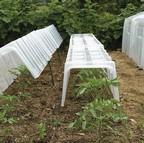
 Organic Grower's Greenhouse
Organic Grower's Greenhouse Plant houses for more flowers
Plant houses for more flowers